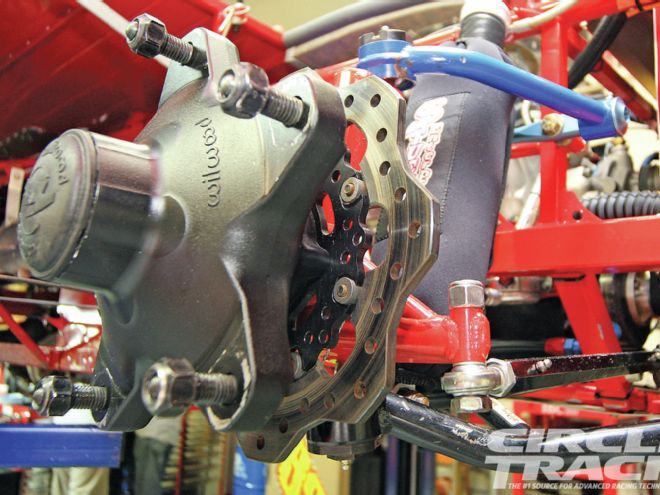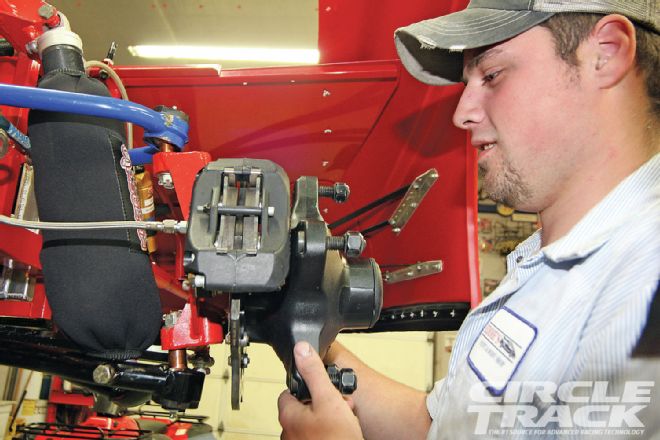
If you look behind the rotor you can see the T-nuts Wilwood uses to float the rotor to the mounting ring. Floating the thin rotors helps keep them from warping and also cuts brake drag.
In the Sep. ’13 issue of Circle Track we walked you through the installation of an ultra-lightweight braking setup from Wilwood. The key to the lightweight setup is swapping out 1.250-inch-thick cast-iron rotors for solid steel rotors that are just 0.380-inch thick. To go with these, we also installed narrower and incredibly strong Forged Narrow Dynalite calipers and Wilwoods redesigned Starlight 55-XD hubs, which cut nearly 5 pounds off of each corner of a Limited Late Model dirt race car.
Following up with Wilwood’s ultra-lightweight braking package to see how it holds up to punishment on the racetrack
Now it’s easy to make practically any racing component lighter by reducing mass. The hard part is to make a lighter component that’s still tough enough to handle the abuse that comes from circle track racing. Because it’s so far outside the norm for stock car racing brakes, we were curious to see how well the Wilwood setup held up. So we followed up with racer Chris Hargett after a couple weekends of racing to get his opinion of how well the brakes worked.
“The brakes, so far, have been a non-issue,” he says, “and I really mean that as a compliment. The stopping power is still there, which is great, and the car does want to get up off the corner better, which comes from cutting that weight. We’ve run Second in our first two races in the Limited Late Model class after moving up from Crates, so we are really happy with how it is all working.
“I know that Wilwood says the lighter pieces do not bleed off heat as well as the traditional cast rotors, so we’re bleeding the brakes after each race to get all the old fluid out of the calipers, and not just burping them to get any air out. I also like that the new Forged Narrow Dynalite calipers will work on either the left or right side of the car. We’re running the same pad on all four corners. The only difference is the caliper on the right front has a smaller set of pistons in it. That lets me carry fewer spares around in the race truck.
 Hargett Racing crew member Cameron Lowman inspects the Wilwood lightweight braking setup after the teams second weekend of racing on the brakes. By going to a Wilwood solid steel rotor that’s just 0.380-inch thick, the team was able to cut nearly 5 pounds off of each corner.
Hargett Racing crew member Cameron Lowman inspects the Wilwood lightweight braking setup after the teams second weekend of racing on the brakes. By going to a Wilwood solid steel rotor that’s just 0.380-inch thick, the team was able to cut nearly 5 pounds off of each corner.
“Wilwood gives you the option to either float the rotors or mount them solid to the hub. We chose to float them. When we first assembled the rotors to the hubs they were pretty tight, but now that we’ve raced them a few times we can tell that the rotors move a little easier back and forth on the hubs. I really believe that floating the rotors helps cut brake drag. You can feel the difference just pushing the car through the pits, so I know it is making a difference on the track.
“I’m really happy with how this brake setup is working out. I know I definitely don’t plan on going back. With my driving style I always use the brakes as little as possible and drive into the corner rather than using the brakes to turn the car, but I know of racers running these Wilwood brakes in the Super class and like them, so I wouldn’t hesitate to run them just about anywhere.”